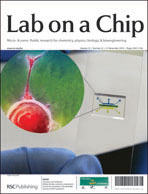A new method is described for two-dimensional (2D) separations using a microfluidic chip normally employed for single dimension electrophoresis. The method employs a combination of gradient elution moving boundary electrophoresis (GEMBE) and chiral capillary zone electrophoresis (CZE). The simplicity of the first dimension GEMBE method enables its implementation in the injection channel of a conventional electrophoresis chip, simplifying the design and operation of the device. The method was used for high resolution 2D chiral separations of a mixture of amino acids considered as possible signatures of extant or extinct life for solar system exploration. The enantiomers of aspartic acid, glutamic acid, serine, alanine, and valine were all resolved as well as glycine (achiral) and several unidentified impurities, giving an estimated peak capacity of 35 for the region between valine and glycine. The results highlight the need for high peak capacity separations for chiral amino acid analysis if accurate enantiomeric ratios are to be determined.

You have access to this article
 Please wait while we load your content...
Something went wrong. Try again?
Please wait while we load your content...
Something went wrong. Try again?


 Please wait while we load your content...
Please wait while we load your content...